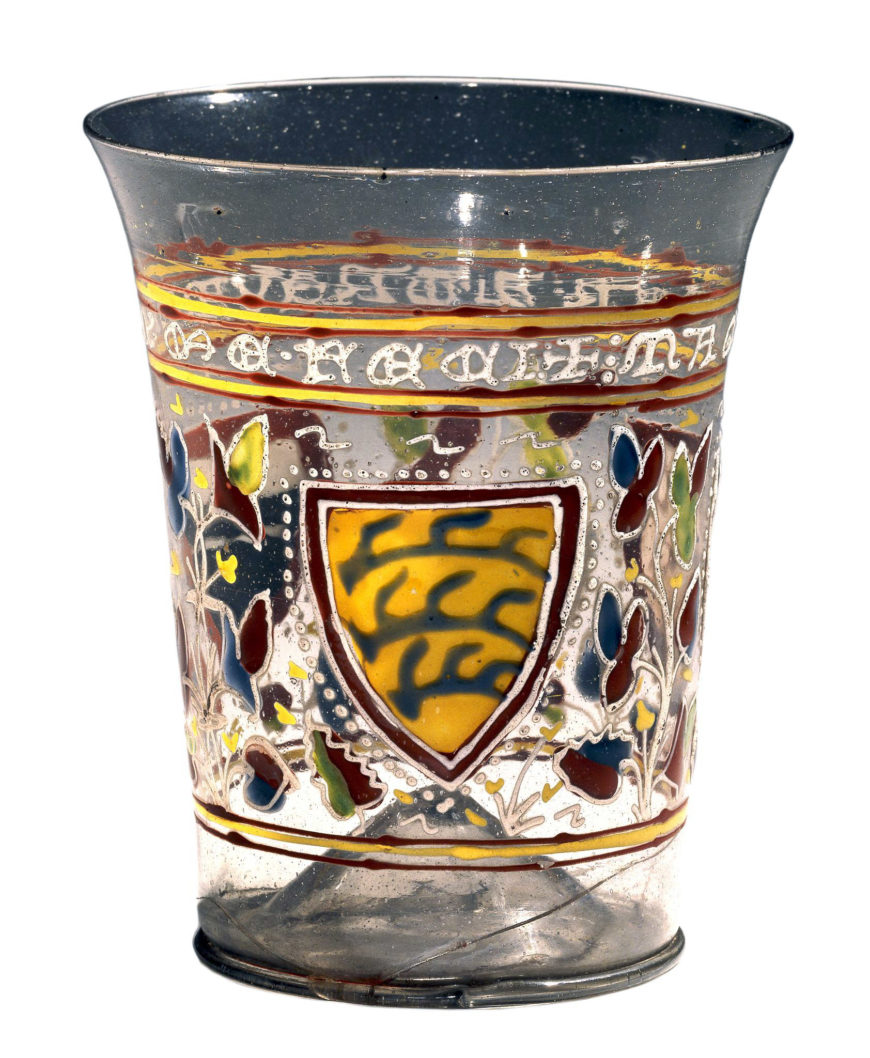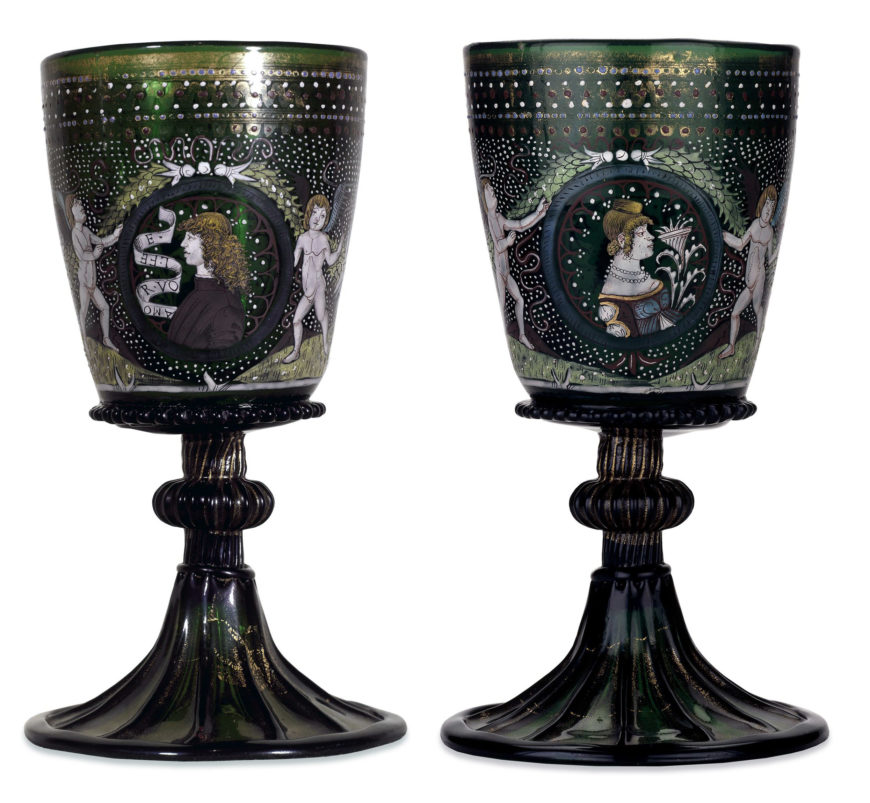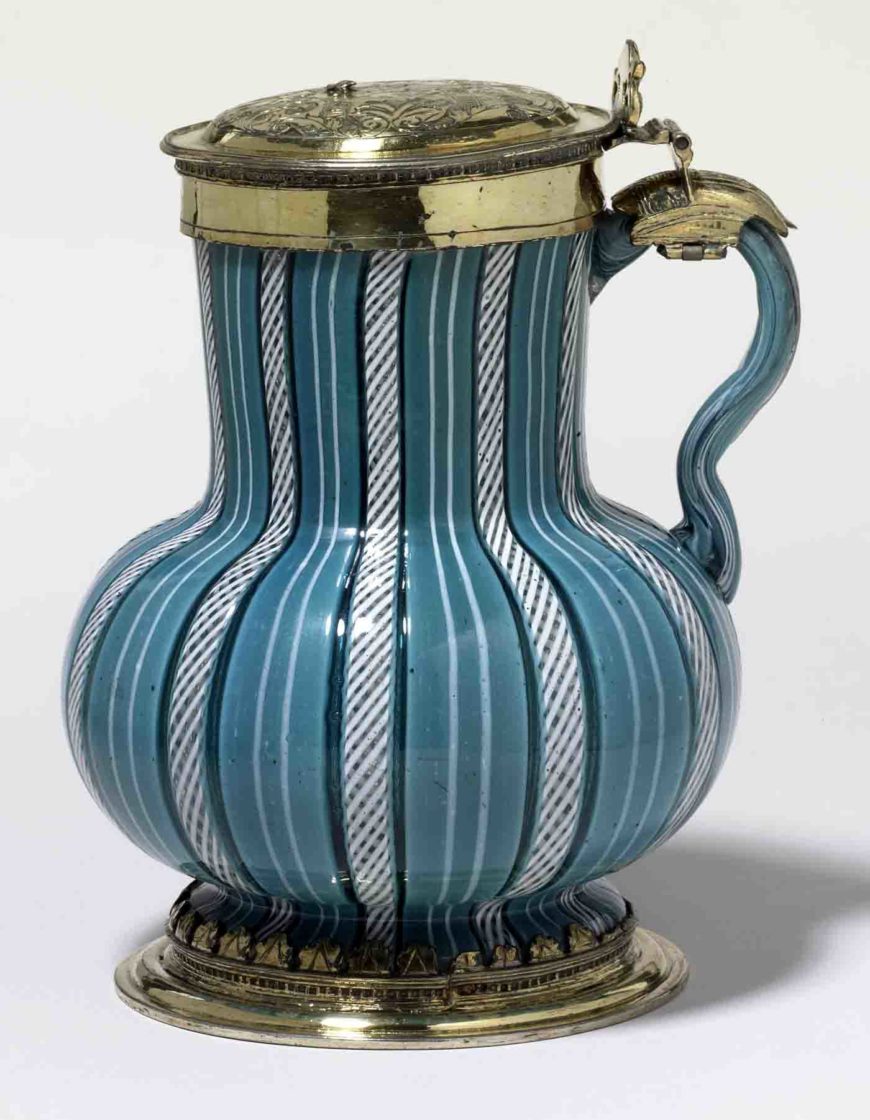
Aldrevandini Beaker, c. 1330, glass and enamel, Venice, Italy, 12.5 cm high (© Trustees of the British Museum)
Venetian glass at the beginning of the fourteenth century
The Aldrevandini beaker is a uniquely well-preserved example from a group of glass vessels produced in Venice at the end of the thirteenth and the beginning of the fourteenth century.
An inscription on the beaker, running between bands of red and yellow paint, reads ‘MAGISTER ALDREVANDIN. ME.FECI’ (‘Master Aldrevandin made me’). Beneath the inscription are three heraldic shields set against a background of leaves. Two of the shields are yellow, one decorated with three blue stags’ horns and the other with red keys. The third consists of black and white horizontal bars. This combination of three different shields suggests that the heraldry is purely decorative and that the beaker was not produced for a specific person or family.
The beaker’s place of manufacture has proved a puzzle to scholars. For many years it was considered to be ‘Syro-Frankish’, based on the theory that Crusaders had commissioned glass from Christian and Jewish glassmakers working in the Islamic tradition on the Syrian coast. But it differs from Islamic glass in a number of ways. Unlike the Aldrevandini beaker, Syrian vessels produced in the thirteenth century tend to taper from the base out to the rim. Also, both the internal and external surfaces of this beaker are painted, whereas Syrian glass is painted only on the external face, and yellow paint has been used rather than gold. But by 1988, after many fragments of similar vessels had been found in excavations in Europe, it was possible to say with confidence that the beaker was produced in Venice.

Glass ‘betrothal’ goblet, attributed to Obizzo, c. 15th century, glass, gold, and enamel, Venice, Italy, 10.5 x 22.3 cm (© Trustees of the British Museum)
Colored glass in the 15th century
The bowl of this emerald-green ‘betrothal’ goblet has painted enamel decoration of two portrait medallions draped with garlands held by putti (cherubs). On one side is a lady with a stylized flower, on the other a gentleman with a scroll bearing the motto ‘AMOR.VOL.FEE’ (‘Love Requires Faith’).
The painted enamel decoration is of extremely high quality. The two profile portraits depict the fashionable Venetians of the social world often seen in the paintings of the artist Vittore Carpaccio (about 1460/5–1525/6). Both portraits and inscription suggest that this glass may have been a betrothal or wedding gift of an élite couple. Betrothal was marked by elaborate gifts and exchanges within the families to be linked by marriage.
Colored glass of varying shades of translucent blue and green, opaque white or turquoise, was perfected in Venice before the end of the fifteenth century. Luxurious gilt and enameled decoration on clear, lattimo (opaque white) and colored glass was especially popular in the European courts. Specialists, some of them women, carried out the painted enamel decoration and applied gold leaf, which were fixed to the surface of the glass in a low-temperature kiln.

Glass tankard with silver-gilt mounts, 1548–49, glass and silver, (mounts hallmarked in London), Venice, Italy, 12.8 cm in diameter (© Trustees of the British Museum)
A new type of decoration
By the second quarter of the sixteenth century, Venetian glassmakers had developed an entirely new type of decoration, composed of opaque-white lattimo (‘milky’) canes which are actually embedded in the glass itself. In the simplest use of the technique (a fili), white canes are incorporated into the colorless body of the glass, forming a series of parallel lines. In a more complex decorative scheme, the plain white canes (a fili) alternate with canes of twisted pattern (a retorti). This tankard features blue and white vetro a retorti
The decorative glass made in Venice and in northern Europe in the ‘façon de Venise‘, was highly valued in England from the mid-sixteenth century; a number are listed in royal inventories, mounted in silver gilt. Although the technique of this tankard is of Venetian glass, the form is derived from contemporary northern European pottery, particularly of the type known as ‘Malling’ tankards. Documents record that in 1549 there were eight glassmakers from Murano (Venice) working under contract in London: it seems likely that this is one of their products.
© Trustees of the British Museum

